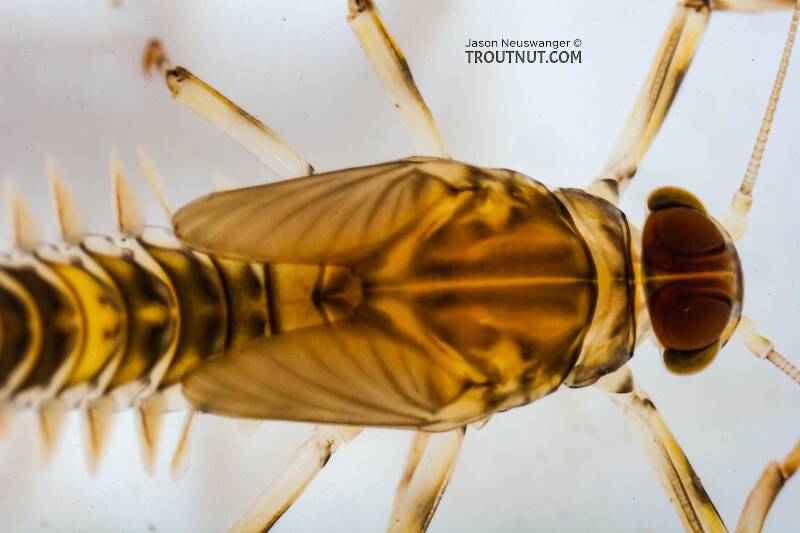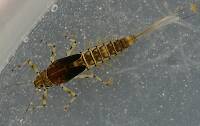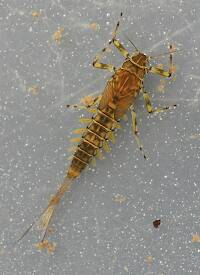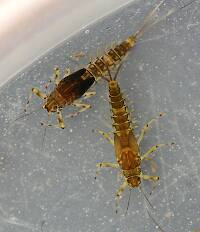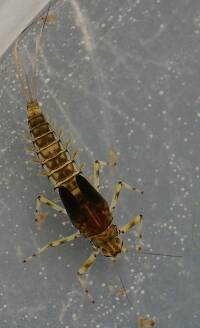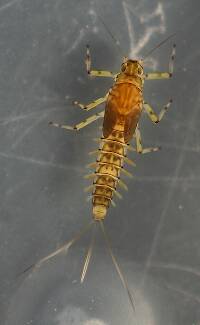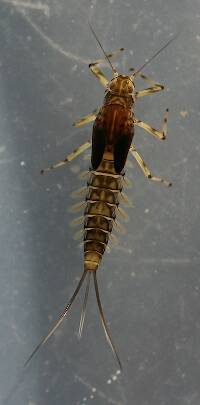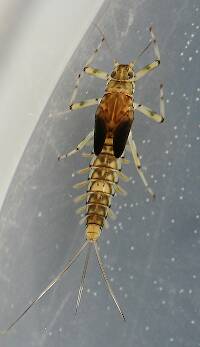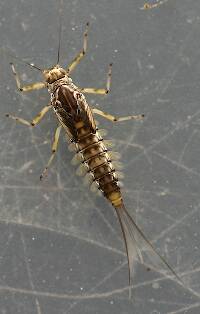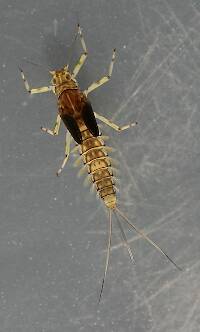
Blue-winged Olives
Baetis
Tiny Baetis mayflies are perhaps the most commonly encountered and imitated by anglers on all American trout streams due to their great abundance, widespread distribution, and trout-friendly emergence habits.
Featured on the forum

Some characteristics from the microscope images for the tentative species id: The postero-lateral projections are found only on segment 9, not segment 8. Based on the key in Jacobus et al. (2014), it appears to key to Neoleptophlebia adoptiva or Neoleptophlebia heteronea, same as this specimen with pretty different abdominal markings. However, distinguishing between those calls for comparing the lengths of the second and third segment of the labial palp, and this one (like the other one) only seems to have two segments. So I'm stuck on them both. It's likely that the fact that they're immature nymphs stymies identification in some important way.

Troutnut is a project started in 2003 by salmonid ecologist Jason "Troutnut" Neuswanger to help anglers and
fly tyers unabashedly embrace the entomological side of the sport. Learn more about Troutnut or
support the project for an enhanced experience here.
Earlfishman
Posts: 17
Posts: 17
Earlfishman on Apr 11, 2007April 11th, 2007, 5:20 pm EDT
Jason,
I really enjoy your site, you've got some great photos and some really good info. I just wanted to let you know that this mayfly looks like it might actually be a Baetis sp., not a Diphetor hageni. Diphetor's antenna would be much closer together at the base and there would definitely be no gill on ab seg. 1. I can't give you a sure ID without photos of the front of the head and the mouth parts.
Keep up the good work.
Earl
I really enjoy your site, you've got some great photos and some really good info. I just wanted to let you know that this mayfly looks like it might actually be a Baetis sp., not a Diphetor hageni. Diphetor's antenna would be much closer together at the base and there would definitely be no gill on ab seg. 1. I can't give you a sure ID without photos of the front of the head and the mouth parts.
Keep up the good work.
Earl
Troutnut on Apr 12, 2007April 12th, 2007, 5:53 pm EDT
Hi Earl,
Glad you like the site. I just re-traced my ID of this specimen in the keys in Merrit & Cummins, and I branch away from Baetis with this one at a couplet checking to see whether a femoral villopore is present. I can't see one on this specimen, so I followed a sequence which led to Diphetor. Perhaps my pictures aren't detailed enough with regard to that feature?
If this becomes really interesting, I can pick the specimen back out of the alcohol and check for that under a microscope. For now I'm going to take your "not Diphetor" ID and reclassify this one as an unknown Baetid.
Glad you like the site. I just re-traced my ID of this specimen in the keys in Merrit & Cummins, and I branch away from Baetis with this one at a couplet checking to see whether a femoral villopore is present. I can't see one on this specimen, so I followed a sequence which led to Diphetor. Perhaps my pictures aren't detailed enough with regard to that feature?
If this becomes really interesting, I can pick the specimen back out of the alcohol and check for that under a microscope. For now I'm going to take your "not Diphetor" ID and reclassify this one as an unknown Baetid.
Jason Neuswanger, Ph.D.
Troutnut and salmonid ecologist
Troutnut and salmonid ecologist
Konchu on Apr 13, 2007April 13th, 2007, 3:25 am EDT
Villipore is often difficult to see; try keying it again, if you get the chance, under the assumption that the villipore is present. What do you get?
Troutnut on Apr 13, 2007April 13th, 2007, 4:04 am EDT
In that case, Baetis. I'll move it there for now.
It is frustrating that even when I take a bunch of really close-up pictures I still don't have what I need to see many of the key features used in identification. I wish I had an electron microscope!
It is frustrating that even when I take a bunch of really close-up pictures I still don't have what I need to see many of the key features used in identification. I wish I had an electron microscope!
Jason Neuswanger, Ph.D.
Troutnut and salmonid ecologist
Troutnut and salmonid ecologist
Earlfishman
Posts: 17
Posts: 17
Earlfishman on Apr 13, 2007April 13th, 2007, 11:37 am EDT
The villipore is actually nearly impossible to see without a compound scope, I really don't like that character.
Keep in mind that when you get to that couplet, you are heading towards only 4 genera. Both Diphetor hageni and Fallceon quilleri have a distinct keel between the antennal bases and Diphetor has no gill on ab 1. Cloedes is seriously geographically restricted and Acerpenna has the pointy gill on seg 7 and a really thick terminal abdominal filament.
Baetis sp. is a safe place to leave that bug.
Earl
Keep in mind that when you get to that couplet, you are heading towards only 4 genera. Both Diphetor hageni and Fallceon quilleri have a distinct keel between the antennal bases and Diphetor has no gill on ab 1. Cloedes is seriously geographically restricted and Acerpenna has the pointy gill on seg 7 and a really thick terminal abdominal filament.
Baetis sp. is a safe place to leave that bug.
Earl
Troutnut on Apr 13, 2007April 13th, 2007, 4:10 pm EDT
Thanks Earl! That should really simplify some of my future ID work.
Are you a professional entomologist?
Are you a professional entomologist?
Jason Neuswanger, Ph.D.
Troutnut and salmonid ecologist
Troutnut and salmonid ecologist
Quick Reply
Related Discussions
Topic
Replies
Last Reply
Re: Help to get some specimens of the isopod Caecidotea communis
In the Arthropod Family Asellidae by Leonardo
In the Arthropod Family Asellidae by Leonardo
11
Mar 29, 2013
by Leonardo
by Leonardo
0
Jun 11, 2023
by Fishohio614
by Fishohio614


